If you had to pick the epicentre of abandoned buildings in the American Rust Belt, many cities can claim that title. The 1970s were not kind to North American industry, and cities like Buffalo, Cleveland, Detroit and many more still feel the sting of that troubled decade. Then there is Gary, Indiana; you can throw a rock in many parts of Gary and break the window of an abandoned building. And despite the stories I had heard about the city being a murder capital with rampant crime and watching not only your car but your wallet. I never once felt uncomfortable in Gary, unlike Detroit, where I was always on edge. While there are many iconic abandoned buildings in Gary, the one that became a fast favourite is City Methodist Church, a towering cathedral of Methodism in the steel-driven 20th Century United States.
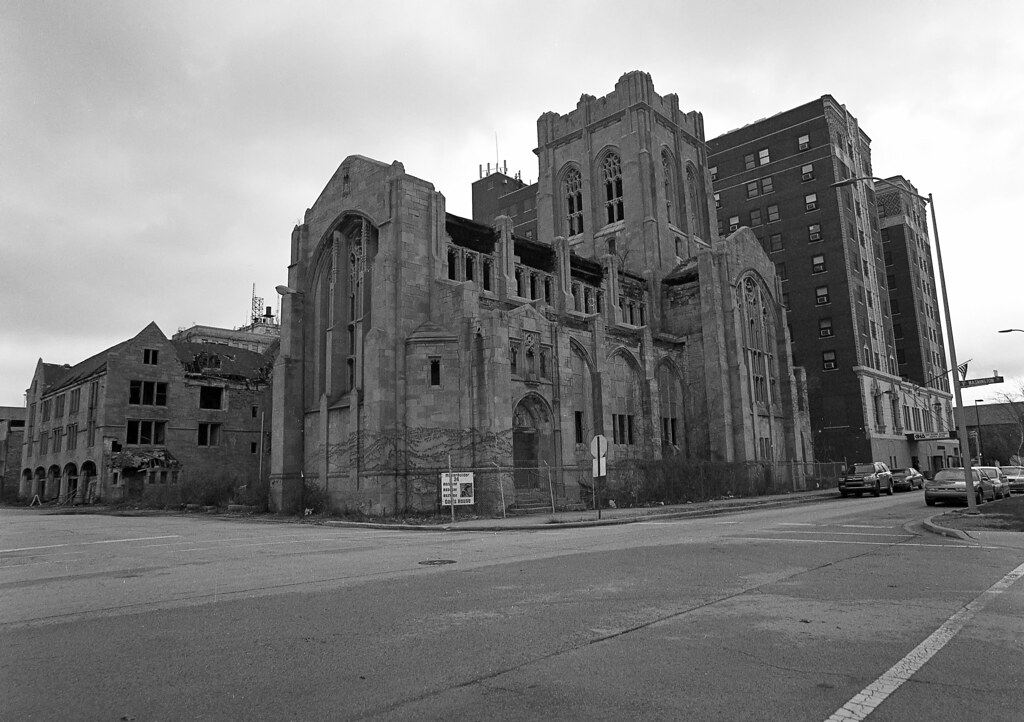
Pentax 645 – SMC Pentax 645 35mm 1:3.5 – Kodak Tri-X Pan @ ASA-250 – PMK Pyro (1+2+100) 10:30 @ 24C
The city of Gary, formed in 1906, takes its name from Elbert H. Gary, one of the founders of the United States Steel Corporation, better known as US Steel. The entire city was formed around a brand-new massive steel mill in 1906. As workers came to the mills, they brought their families, and like any community, churches followed. Gary First Methodist Church was formed in 1906 and, like many Methodist congregations, worshipped in any building that would provide them space, usually halls and schools. The congregation constructed their first church building 1912 at 7th Avenue and Adams. In 1916, the congregation called a dynamic new pastor, Rev Dr William Seaman. Rev Seaman had some new ideas on bringing better morality to the company town, and in 1917, began to court US Steel to move the congregation from the outskirts of the growing city to the downtown. The pastor saw it as a duty to engage the city’s working-class regardless of race and fight back against the numerous drinking establishments and brothels that dotted the downtown. Rev Seaman convinced US Steel to donate a plot of land at 6th Ave and Washington St and front half the funds needed to construct the new church. Lowe & Bollenbacher of Chicago won the contract to build the brand new Gothic Revival Church, and the cornerstone was laid in 1925. In addition to a sanctuary, the new complex included a dedicated 1,000-person theatre named Seaman Hall, a whole Sunday School wing with a gym, and a library, classrooms, and offices. The sanctuary saw completion in 1926, with the first service being held on 3 October, complete with music provided by an organ donated by Elbert Gary. It wasn’t until 1927 that the additional buildings were completed. Plans had been made to include a rooftop garden and bowling alley, but these were dropped. But in the era of Jim Crow laws and other efforts to suppress the black population, Rev Seaman fought back. He refused to screen the film The Birth of a Nation and supported interfaith cooperation and cultural diversity. His actions saw the KKK make threats, and even the congregations turned against him. Rev Seaman was eventually forced out by the congregation in 1929. In an ironic twist, his replacement proved even less popular. The stock market collapse caused some difficulties for the church. They rented out sections of the Sunday School wing to local schools and even Indiana University. Rev Seaman, despite being forced out upon his death in 1944, had his ashes interred at City Methodist.

Nikon D300 – AI-S Nikkor 50mm 1:1.4

Nikon D300 – AF-S Nikkor 14-24mm 1:2.8G

Nikon D300 – AF-S Nikkor 14-24mm 1:2.8G

Nikon D300 – AF-S Nikkor 14-24mm 1:2.8G

Nikon D300 – AF-S Nikkor 14-24mm 1:2.8G
The post-war boom saw the church population explode through the middle of the 20th Century. This was helped by an increase in the city’s black population seeking jobs at US Steel and the return to ministering to the non-white population. It also put the church leadership at odds with the longtime white members, many of whom did not support the idea of integrated worship. But the numbers didn’t lie, and the church population peeked through the decade at 3,000 members, almost all attending Sunday services and packing the massive sanctuary. But the 1960s saw many of the far more affluent white families flee from the inner city, leaving the poorer black families holding the bag for maintaining the large church. The rapid changes to the church and city’s population was the world Rev S Walton Cole entered in 1964. Rev Cole would take greater strides in engaging the city’s black and Hispanic populations, supporting integration and ministering to the changing city. In some cases, he succeeded, but he often needed to catch up on his efforts. With a dwindling membership, the congregation sought to offload the ageing building to another congregation and hoped to bolster the ageing population of only 320 members on paper. But the other churches were suffering similar realities, and by 1975, the congregation folded, and ownership of the property fell to the University of Indiana. The University continued to use the Sunday School Wing and Seaman Hall but closed the doors on the sanctuary. A fire in 1997 caused enough damage to see the University divest itself of the property. Over the next few years, the church fell into disrepair, spurred on by vandalism, and anything of value was quickly stripped. It did see some use in film and television production, but nothing to see it restored. The city floated the idea of turning the sanctuary into a ruins garden and multi-use public space in the early 21st Century but never moved on the plan. A section of the Sunday School wing roof collapsed in 2011, which only accelerated the structural collapse of the building. The collapse of a large section of the sanctuary roof in the late 2010s would again see the city return to the idea of a ruins garden and move forward on the plan. A grant came in 2017 from the Knight Foundation. In 2019, those funds were used to conduct an environmental cleanup of the property and the placement of a historical marker. They added security to prevent access (with little good). Although the entire project remains in limbo by this point, a second grant was applied for in 2022 but was denied.
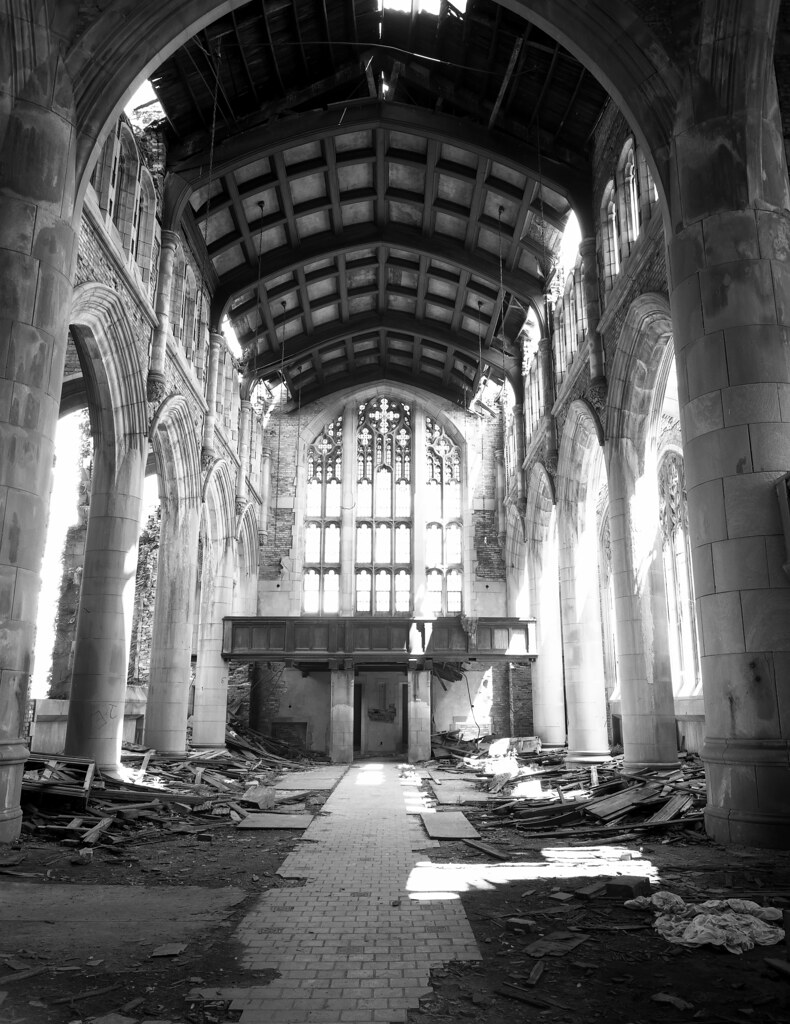
Anniversary Speed Graphic – Schneider-Kreuznack Angulon 1:6,8/90 – Ilford Delta 100 @ ASA-100 – Blazinal (1+25) 7:00 @ 20C

Anniversary Speed Graphic – Schneider-Kreuznack Angulon 1:6,8/90 – Fuji Provia 100F @ ASA-100 – Processing: Toronto Image Works

Nikon D300 – AI-S Nikkor 50mm 1:1.4

Nikon D300 – AI-S Nikkor 50mm 1:1.4
I only went to City Methodist twice, as one does not lightly drive a long distance to check out the exact location in a city filled with exploring opportunities. But the fact that I went twice shows how much I enjoyed the area because of the scale and its photographic opportunities. But also, with how easy it was to get inside, in 2013, Gary had yet to crack down too much on photographers who went into their abandoned properties. You could park right outside and walk in without too much of a person paying attention to you. What first struck me was how bad the church interior had become; you always had to watch your step, especially once you got up to the second and the third floor of the Sunday School wing. It struck me at the size of the building; here in Canada, Methodist (United) churches were often smaller with little ornamentation. However, the size and stature of the structure spoke to what Rev Seaman was hoping for a public location where everyone was welcome. It also appeared to be more Anglican or even Roman Catholic in appearance once you got into the sanctuary. The property was also empty, with no pews and a few pieces of furniture, and even the organ and the pipes were long gone. The second trip later that year proved far more dangerous; I went solo to the church, parked and walked in; I went strictly to get some better exterior shots and wide-angle interior shots and even saved a roll of Tri-X 320 in 120 for that purpose. After polishing off the roll, I noted the clouds were rolling in faster, and then the sirens. No police sirens, air raids, or, in this case, tornado sirens. I noped out of the place so fast that I even surprised a policeman who rolled by and saw a car with an Ontario plate caught his eye. At this point, the city required a permit to photograph inside the building, so if they had stopped me, I would have been in trouble. Thankfully, I got away scot-free and never went back.

Rolleiflex 2.8F – Carl Zeiss Planar 80mm 1:2.8 – Adox CHS 100 @ ASA-100 – Blazinal (1+25) 6:00 @ 20C

Rolleiflex 2.8F – Carl Zeiss Planar 80mm 1:2.8 – Adox CHS 100 @ ASA-100 – Blazinal (1+25) 6:00 @ 20C

Rolleiflex 2.8F – Carl Zeiss Planar 80mm 1:2.8 – Adox CHS 100 @ ASA-100 – Blazinal (1+25) 6:00 @ 20C

Rolleiflex 2.8F – Carl Zeiss Planar 80mm 1:2.8 – Adox CHS 100 @ ASA-100 – Blazinal (1+25) 6:00 @ 20C

Rolleiflex 2.8F – Carl Zeiss Planar 80mm 1:2.8 – Adox CHS 100 @ ASA-100 – Blazinal (1+25) 6:00 @ 20C
I had forgotten how much film I shot at City Methodist, far more film than digital. Which for 2013 is not that surprising. By this point, I was comfortable working with my D300 and film-based media in abandoned buildings. I wanted to do a lot more experimentation. My compositions are clean, often with leading lines, as seen in my sanctuary shots. sanctuary to capture the grandeur of the space using the 14-24mm, 35mm on the Pentax 645 and 90mm on the 4×5. And yes, I lugged the 4×5 along and captured several sheets while in Gary. However, my choice of using the colour slide film in Seaman’s Hall rather than the sanctuary could be clearer looking back. My choices of Black & White films were perfect. Adox CHS 100 ART, the old rebranded Efke R100 paired with Rodinal, is made for beautiful images. I rocked the 6×6 format with that roll. My favourite is the roll of Tri-X 320. It was one of my last rolls of the older Tri-X formula. Paired with PMK Pyro, it rendered crispy, high-contrast images that worked well. I only wish it was during better conditions and not under a tornado threat. Another odd thing is that I did a lot of portrait orientation over the landscape.

Pentax 645 – SMC Pentax 645 35mm 1:3.5 – Kodak Tri-X Pan @ ASA-250 – PMK Pyro (1+2+100) 10:30 @ 24C
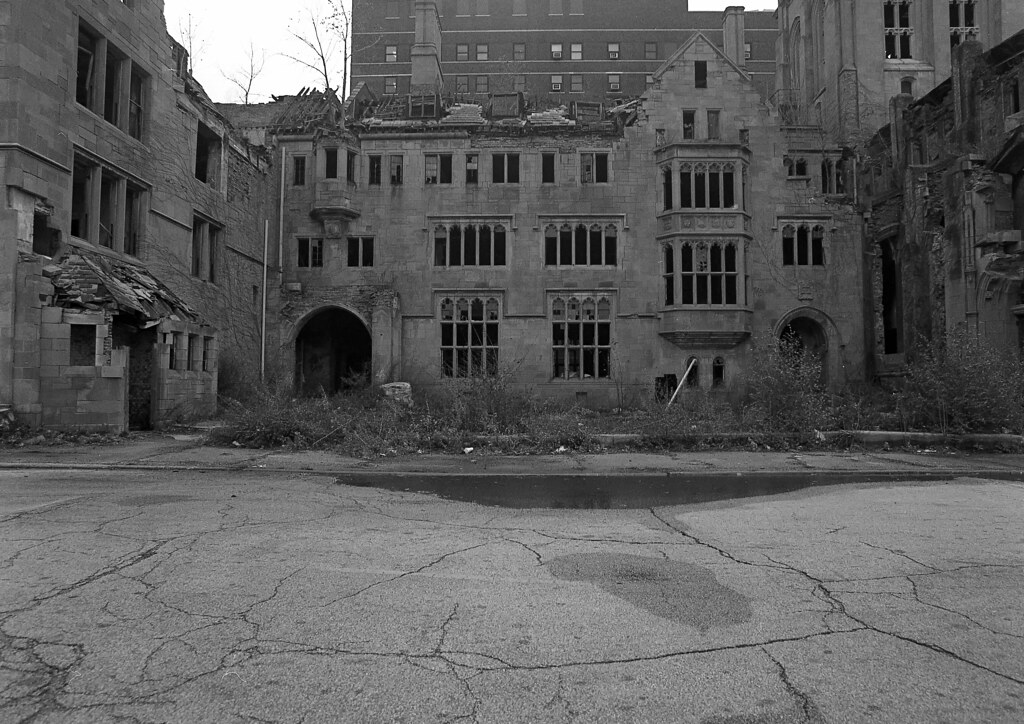
Pentax 645 – SMC Pentax 645 35mm 1:3.5 – Kodak Tri-X Pan @ ASA-250 – PMK Pyro (1+2+100) 10:30 @ 24C
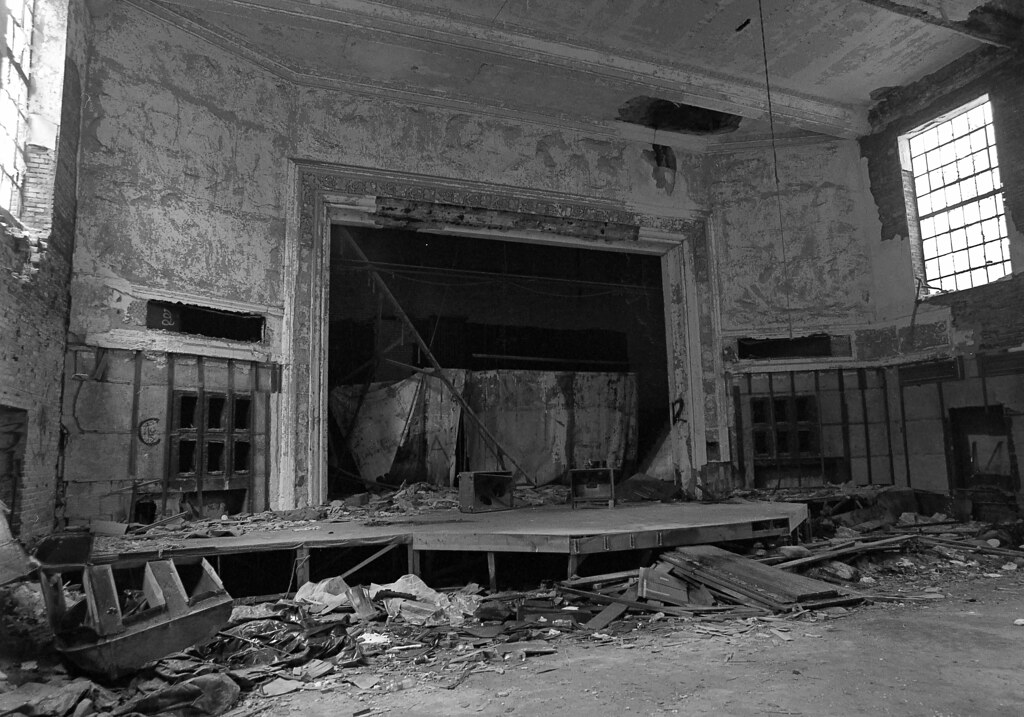
Pentax 645 – SMC Pentax 645 35mm 1:3.5 – Kodak Tri-X Pan @ ASA-250 – PMK Pyro (1+2+100) 10:30 @ 24C
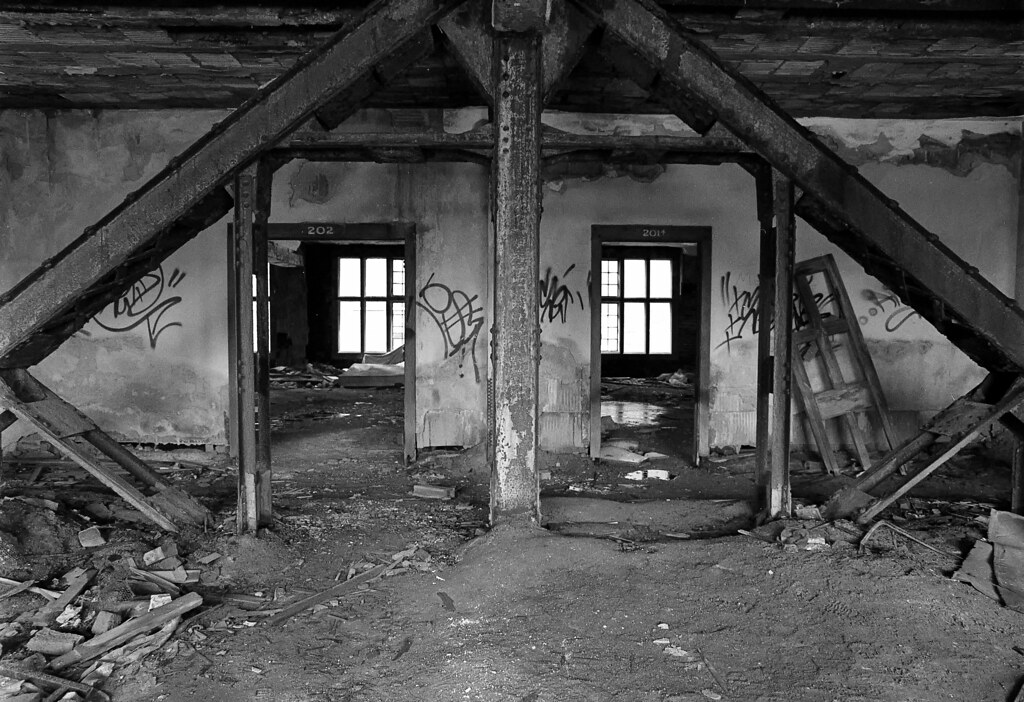
Pentax 645 – SMC Pentax 645 35mm 1:3.5 – Kodak Tri-X Pan @ ASA-250 – PMK Pyro (1+2+100) 10:30 @ 24C

Pentax 645 – SMC Pentax 645 35mm 1:3.5 – Kodak Tri-X Pan @ ASA-250 – PMK Pyro (1+2+100) 10:30 @ 24C
I fondly remember City Methodist; I’m glad to see this beauty before the sanctuary roof collapsed. If you are passing through Gary or are willing to make a detour. In that case, I highly recommend seeing it from the exterior. Not only does it represent the boom and bust of the city, but it also ties into the history of the United States and its troubled relationship with racism and the church’s response to the rapidly changing population of the 1960s and 1970s. I hope that the city can preserve and reuse the building in some form. I feel the multi-use ruins garden is a spectacular way to keep the site, but there is still the question: would such an investment see public good and use? Either way, the story of City Methodist is far from over. You can check out all my images from my trips on Flickr.
These are great shots, Alex! I work a lot with abandoned and disused buildings, and often see their beauty in unusual places. The black and white images are great, but my personal favorites are the color images featuring a single color aspect. Andy